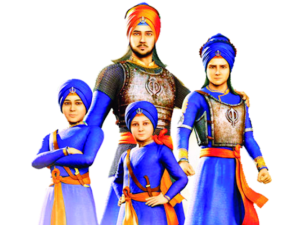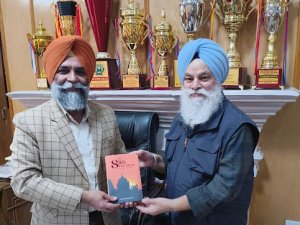The Sikh attacks on Delhi between 1766 and 1788 reflect a historical context deeply rooted in religious persecution and atrocities suffered by the Sikh community under Mughal rule. The traumatic events involving Guru Teg Bahadur Ji's martyrdom at Chandi Chowk on Aurangzeb's orders and the immense hardships endured by Guru Gobind Singh, including the loss of his four sons in the Battle of Chamkaur and the brutal stoning of two by Wazir Khan in Sirhind, contributed to a profound aversion among Sikhs toward Delhi.
The repeated assaults on the capital can be seen as a response to the injustices and massacres inflicted upon the Sikh community, exemplified by the Chhota Ghallughara and other atrocities in Punjab under Mughal rulers. These historical grievances fueled a determination among Sikhs to assert their identity and seek justice, leading to the series of sieges on Delhi during the specified period. The Sikh resistance against the Mughal oppression represented a struggle for religious freedom and retribution for the profound sufferings endured by their spiritual leaders and the broader Sikh populace in the face of systematic persecution. The annals of Sikh history are replete with tales of valor and conquest, marking pivotal moments in their struggle against various adversaries. Amidst these narratives, a significant artifact emerges—the historic Stone Throne preserved in Ramgarhia Bunga at Amritsar. This exploration delves into the origins, significance, and preservation of this invaluable relic, shedding light on its role in the Sikh-Mughal encounters of the late 18th century.
In the turbulent years of the late 18th century, the Sikhs, led by formidable figures such as Sardars Sahib Singh, Dayal Singh, Lajja Singh,Jassa Singh Ahluwalia, Jassa Singh Ramgarhia and others orchestrated a series of raids against the Mughal Empire. The Battle of Kunjpura in 1772 stands as a testament to their resilience, culminating in the defeat of Mughal forces and a subsequent siege of Sirhind.
The Sikhs' relentless raids on Delhi and its vicinity unfolded in multiple phases, each marked by strategic brilliance and audacious moves. From the plundering of Paharganj in 1770 to the triumphant capture of Delhi in the Battle of Delhi (1783), the Sikhs etched their indomitable spirit onto the canvas of history. Amidst this backdrop, the Ramgarhia Bunga at Amritsar emerged as a crucial hub for Sikh leadership and strategic planning. Preserved within its hallowed confines is a historic Stone Slab, believed to encapsulate the essence of Sikh triumphs against the Mughals.
The intricately inscribed Stone Throne serves as a tangible link to the past, recounting the exploits of Sikh leaders and the events that transpired during their campaigns. Its preservation within the Ramgarhia Bunga not only commemorates the bravery of the Sikhs but also symbolizes the enduring spirit of a community striving for sovereignty. Beyond its aesthetic and historical appeal, the Stone Slab serves as a mnemonic device, ensuring that the sacrifices and victories of the Sikh warriors are eternally embedded in the collective memory. It stands as a silent witness to the tumultuous encounters with the Mughals, narrating a saga of resistance, resilience, and eventual triumph.
The Ramgarhia Bunga, a structure within the Darbar Sahib (Golden Temple) complex, holds a significant historical legacy dating back to the 18th century. Constructed by Jassa Singh Ramgarhia, its primary purpose was to safeguard the Darbar Sahib from potential invasions by foreign rulers. This architectural gem, initially accessible solely from the Guru Ram Das Langar Hall, underwent a restoration process, making it reachable from the parikrama around the holy Sarovar (water tank). While the entrance through the langar hall was unknown to most devotees, the recent restoration aims to enhance accessibility. The Bunga's historical richness is underscored by its housing of the Takht-e-Taus, a granite slab from the Red Fort used in the coronation of Mughal emperors in Delhi.
Seized by Sikhs during an assault on Mughal armies, it symbolizes the end of the Mughal Empire with the removal of their coronation stone. In celebration of Jassa Singh Ramgarhia's 300th birth anniversary, the Shiromani Gurdwara Parbandhak Committee (SGPC) reopened the Bunga after extensive restoration, marking the completion of over 97 % of the restoration work. The Bunga, known for its distinctive four towers, faced damage during Operation Bluestar, prompting subsequent renovations. The ongoing restoration, initiated in 2021, not only focuses on rebuilding damaged towers but also preserves the foundational elements laid by Jassa Singh Ramgarhia in 1755. This meticulous restoration effort ensures that the Ramgarhia Bunga continues to stand as a testament to Sikh history and architectural brilliance within the revered Darbar Sahib Complex.
The historical narrative recounts that a rectangular stone slab measuring 6 feet by 4 feet by 9 inches was reportedly uprooted, secured, and transported to the Ramgarhia Bunga in Amritsar by Jassa Singh Ramgarhia, the chief of the Ramgarhia Misl. This purported relic, believed to have originated from the Peacock Throne, allegedly played a role in the saga of the combined Dal Khalsa forces' capture of the Red Fort in 1783. This stone pedestal, purportedly utilized as a throne by the Mughal Emperor in Diwan-e-am. It is noteworthy that the described throne exhibited distinctive color strappings, adding an intriguing layer to its historical significance. Furthermore, the Sikh Army, under the leadership of Jassa Singh Ramgarhia, utilized red stones from the Red Fort to construct Ramgarhia Bunga. This strategic endeavor aimed to emulate the architectural semblance of a miniature Red Fort, a testament to Baba Jassa Ramgarhia Singh's visionary contribution to Sikh history.
The commemoration of the capture of Delhi by Sikh missile leaders in 1783, notably led by Jassa Singh Ahluwalia, Jassa Singh Ramgarhia, and Baghel Singh, remained overlooked by Sikh organizations until the initiative of S. Tarlochan Singh (MP). His written acknowledgement and appeal to the Delhi Sikh Gurdwara Management Committee prompted the recognition of this pivotal victory day. Under the presidency of S. Manjit Singh, the decision to celebrate this triumph annually outside the Red Fort has endured, marked by the display of posters, paintings, and notable events such as the March of Sikhs on Red Fort in subsequent years, symbolizing the enduring historical resonance of this epochal event.
The historic Stone Throne preserved in Ramgarhia Bunga at Amritsar stands as a poignant relic encapsulating the valorous exploits of the Sikhs during their tumultuous encounters with the Mughals. Its intricate inscriptions and historical significance make it an invaluable testament to a crucial chapter in Sikh history, offering a tangible connection to the past and inspiring reverence for generations to come.







